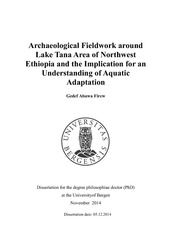| dc.description.abstract | I have in this thesis attempted to investigate prehistoric adaptations around Lake Tana- Blue Nile basin of Northwest Ethiopia. The archaeological excavation conducted at a small rock shelter on the shore of Lake Tana provided evidence of occupation going back to the sixth millennium BP. The faunal remains and the location of the site clearly indicate that the nature of subsistence can be described as an aquatic adaptation. The archaeological assemblage dominated by wild fauna, mainly fish, and the abundant lithic tools and pottery material suggest prehistoric adaptation that was practiced in many aquatic sites of sub-Saharan Africa since at least the early Holocene. However, unlike many of those sites, Kurtiye rock shelter lacked elaborate fishing equipment such as bone harpoons and spears, stone rings and grooves, and pottery with distinctive decoration motifs (incised and dotted impressed wavy line). In addition, there was no evidence indicating adoption of new agricultural subsistence strategies until about the end of the first millennium BC. This appeared to contrast with the situation in many aquatic sites of sub-Saharan Africa. The lack of evidence suggesting early sedentary settlement and transition to food production, in an apparently such rich aquatic area, may therefore reflect local variations and differentiations of aquatic adaptation. The absence of the distinctive markers of the aquatic culture of sub- Saharan Africa, bone harpoon and wavy line pottery, indicates that the site represents a local variation of the aqualithic type of adaptation. Certain pottery decoration motifs, however, show some similarities with material recovered from sites in the Sahara, Nile Valley and eastern Africa regions which may indicate regional and interregional contact, which could also involve diffusion or spread of material culture including domestic species. Nevertheless, remains of domestic animals appeared very late at Kurtiye. This is surprising if it is viewed from the severe climatic and environmental changes of mid Holocene and possibly extensive interregional contacts the site had. Understanding the reasons why and how hunting, gathering and fishing persisted so long as the main economic activities in the region until the historic period is thus challenging. Based on examination of the archaeological evidence using palaeoclimatic and environmental data, pertinent theoretical perspectives and ethnographic insights, the thesis concluded that this situation might have been related to local environmental, socio-cultural and symbolic factors. The long continuity of aquatic adaptation in the region might have been due to the abundance of wild resources, mainly aquatic. Various local environmental constraints including the cold plateau highlands might have affected human settlement and demography, early introduction of domesticates, and possible subsistence modification. Socio-cultural and symbolic traditions related to aquatic resources, as indicated in the ethnographic data, might have been additional factor. Their role seems crucial if we examine them in relation to the severe climatic and environmental changes of mid Holocene and wide interregional contacts. The contribution and importance of this factor may be inferred from the hunting and fishing Woyto of Lake Tana whose subsistence, socio-cultural, symbolic and ritual life have remained closely attached to the aquatic bodies. Opportunities and constraints of the local environment and locally embedded socio-cultural and symbolic values may explain for continuation of hunting and foraging ways of life around the site. The nature of the material remain, the site and its ethnographic evidence examined therefore support the assumptions that prehistoric human adaptive response were influenced both by local environmental situation and human traditions. More archaeological data are critically required to support this interpretation. | en_US |
